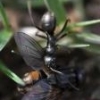- Formiculture.com
- Forums
- Gallery
- Members
- Member Map
- Chat

Introducing Temnothorax queen to mature colony
Started By
goliat314
, Jan 23 2017 8:30 AM
4 replies to this topic
#1
 Offline
-
Posted January 23 2017 - 8:30 AM
Offline
-
Posted January 23 2017 - 8:30 AM
There have some recent posts about combining different species with one another that sparked heated debate. This post is sort of related to this topic. See the queen of my Temnothorax nylanderi colony has gone completely missing, nowhere to be found in their formicarium or the outworld. Before she escaped she seemed very anxious, nerver standing with her brood, constantly roaming the outworld etc. Because of this behaviour I am 99% sure she squeezed out of a crack in the outworld wall(queens of this species look almost identical to workers, add around 1mm or so to the thorax). I noticed this crack right before putting them into hibernation as I saw an ant walking on top of the outworld. I've checked the ants multiple times during the hibernation months but alas, no queen.
The thing with Temnothorax species(often refered to as acorn ants) is that they are very passive ants who avoid conflict with other ant species at all cost, especially Formica species, which they often live right next to for protection. They also form very small mature colonies of only around 50-200 workers despite their size of only 2-3 mm. It would be a shame for this colony to fizzle out since I have plans for a multi species outworld with my Formica cinerea, so perhaps there is a way to introduce another Temnothorax nylanderi queen to the colony somehow? Especially since they are such a calm species and the fact that they are still hibernating. I know that there is no method that works 100%, but how would you go about Introducing another queen to such a passive colony?
Thanks in advance!
The thing with Temnothorax species(often refered to as acorn ants) is that they are very passive ants who avoid conflict with other ant species at all cost, especially Formica species, which they often live right next to for protection. They also form very small mature colonies of only around 50-200 workers despite their size of only 2-3 mm. It would be a shame for this colony to fizzle out since I have plans for a multi species outworld with my Formica cinerea, so perhaps there is a way to introduce another Temnothorax nylanderi queen to the colony somehow? Especially since they are such a calm species and the fact that they are still hibernating. I know that there is no method that works 100%, but how would you go about Introducing another queen to such a passive colony?
Thanks in advance!
#2
 Offline
-
Posted January 23 2017 - 8:45 AM
Offline
-
Posted January 23 2017 - 8:45 AM
Yes there is. I believe that Temnothorax nylanderi is olygogynous and will readily accept new queens.If I were you I might put one or two workers with her and if they don't attack her, put her in the outworld.
- goliat314 likes this
Visit us at www.canada-ant-colony.com !
#3
 Offline
-
Posted January 23 2017 - 8:55 AM
Offline
-
Posted January 23 2017 - 8:55 AM
If this is true It would be fantastic! Can't belive my luck! Is this behavior common? Oh well, now I guess I have to get my hands on a new queen for these girls.Yes there is. I believe that Temnothorax nylanderi is olygogynous and will readily accept new queens.If I were you I might put one or two workers with her and if they don't attack her, put her in the outworld.
Thank you for your reply!
Edited by goliat314, January 23 2017 - 8:57 AM.
#4
 Offline
-
Posted January 23 2017 - 9:34 AM
Offline
-
Posted January 23 2017 - 9:34 AM
I know temnothorax curvispinosus here almost always accept new queens. In fact, they would probably be dead if they didn't as the winter kills a large portion of the colony including some of the queens. I believe that this behaviour also occurs in Temnothorax nylanderi.
Visit us at www.canada-ant-colony.com !
#5
 Offline
-
Posted January 23 2017 - 10:45 AM
Offline
-
Posted January 23 2017 - 10:45 AM
I know temnothorax curvispinosus here almost always accept new queens. In fact, they would probably be dead if they didn't as the winter kills a large portion of the colony including some of the queens. I believe that this behaviour also occurs in Temnothorax nylanderi.
Does this mean some of the workers can reproduce as well if need be (source):
"Worker reproduction does occur with some male production possible from worker derived eggs. Reproductive workers contain 2 ovarioles"
0 user(s) are reading this topic
0 members, 0 guests, 0 anonymous users
















